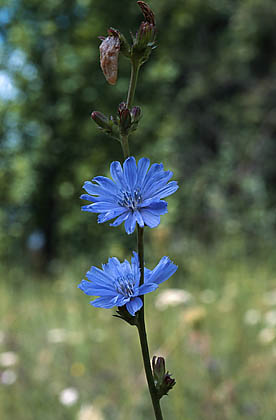Pretty naturalised stranger
Photo: Arne Ader
Translation: Liis
Chicory
Chicory Harilik sigur Cichorium intybus
The truth about chicory is that it is not an ancient natural species here and it has not really made itself quite at home in the natural biotopes. It grows mostly on waste lands, on the verges of all kinds of roads, also near railways or houses: in company with grasses, plantains or meadow-grasses or in the garden bed as an ornamental.
The coffee bush is a tropical plant but coffee-drinking is a very old custom in our country too. Chicory coffee was used as a substitute in poor or war years. The plant has a thick and fleshy root that after drying and grinding was made into a bitter coffee substitute. So chicory seeds arrived in Estonia and chicory was grown successfully at our farms too. Chicory is found on all the continents except at the poles.
The chicory flowerheads resemble somewhat those of cornflowers but they are made up of a different kind of flowers: the chicory has only ray florets and no disk florets. The cornflower flowerheads are in the tips of stems and stem branches, chicory flowers are in the axils of stem leaves, on short stalks. The usual flower colour is blue, seldom pink or white.
The stem of the plant is upright and angular, hollow, covered with rough hairs. It branches in the upper part, stem leaves are few and they are small and oblong.









